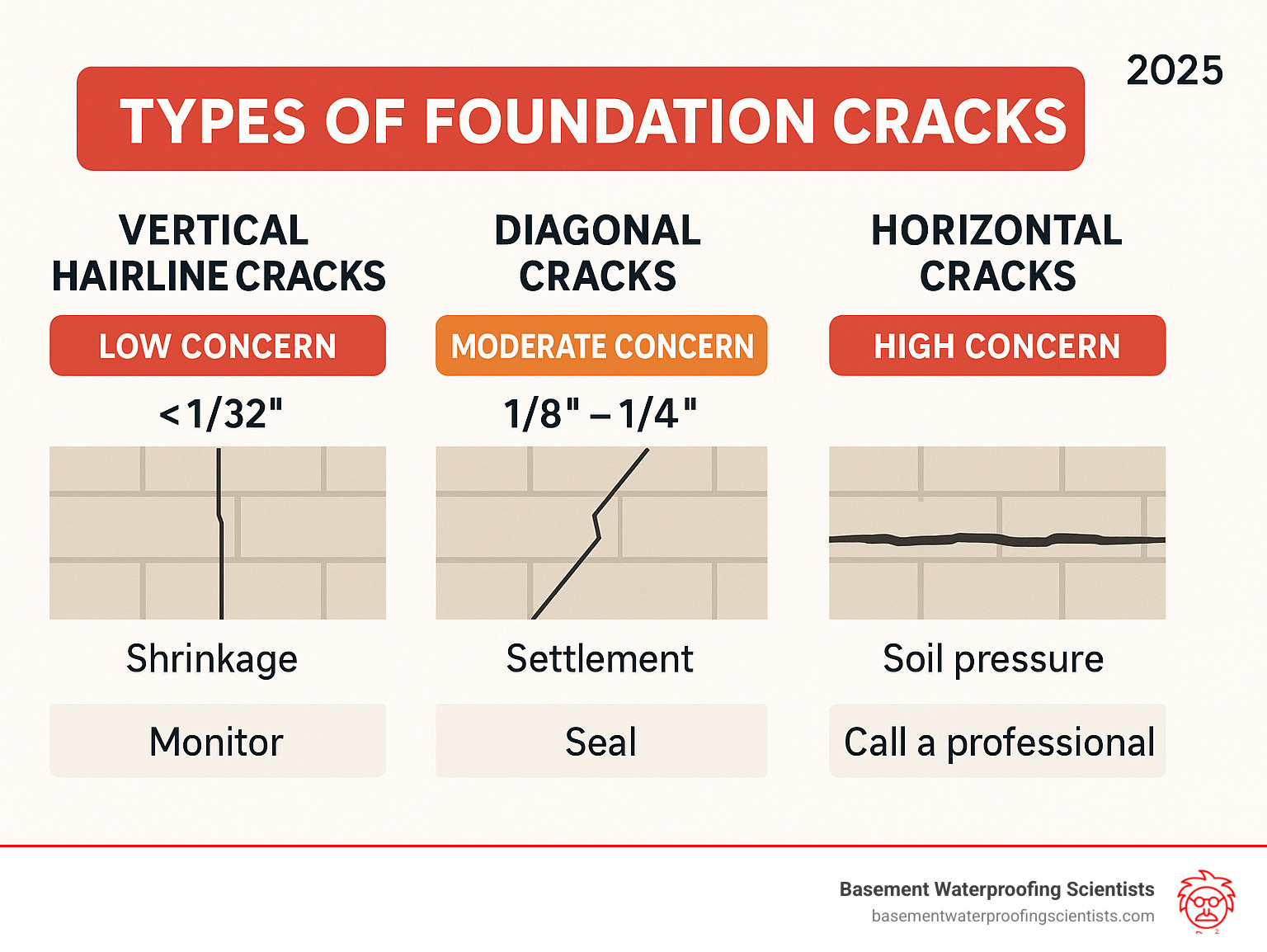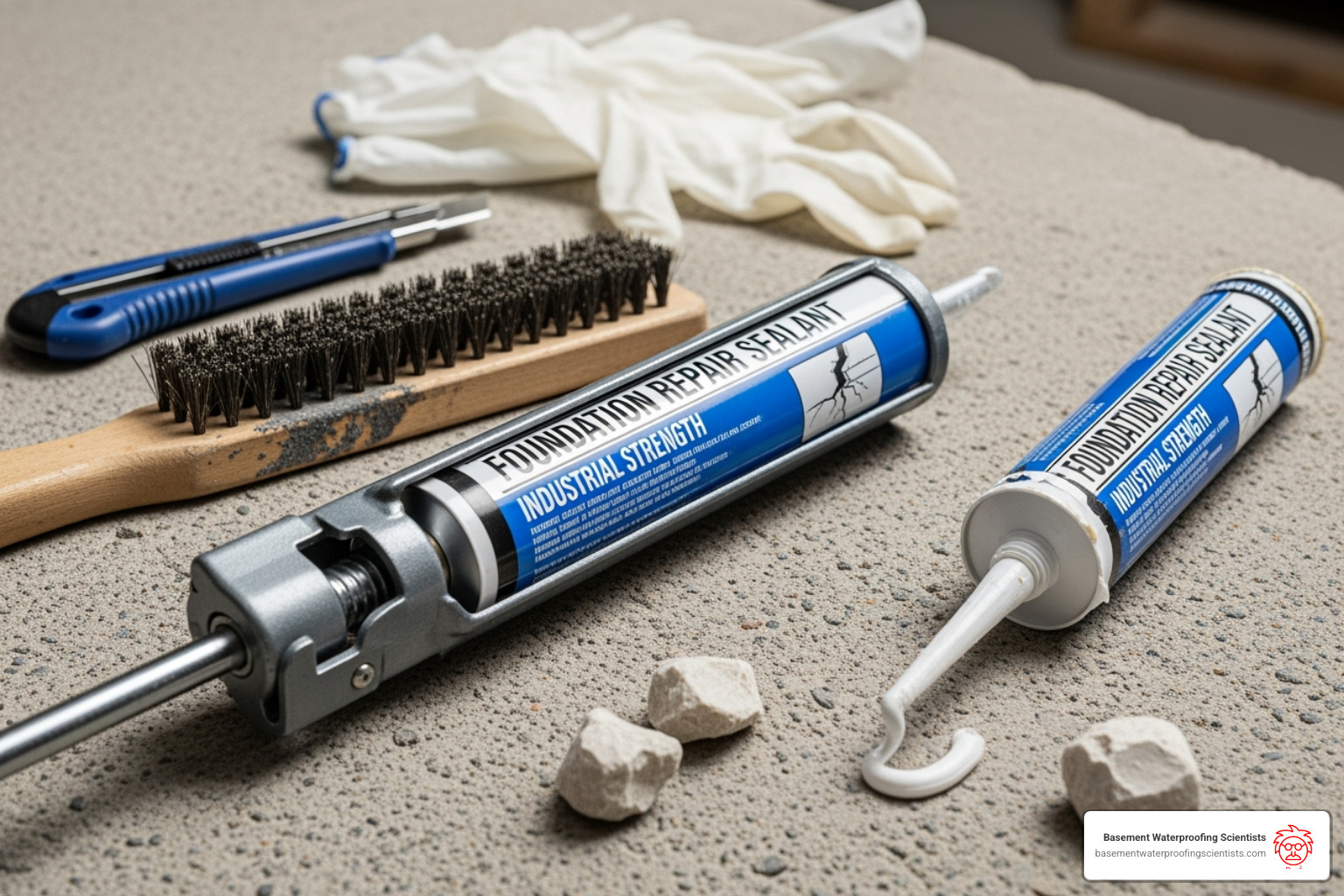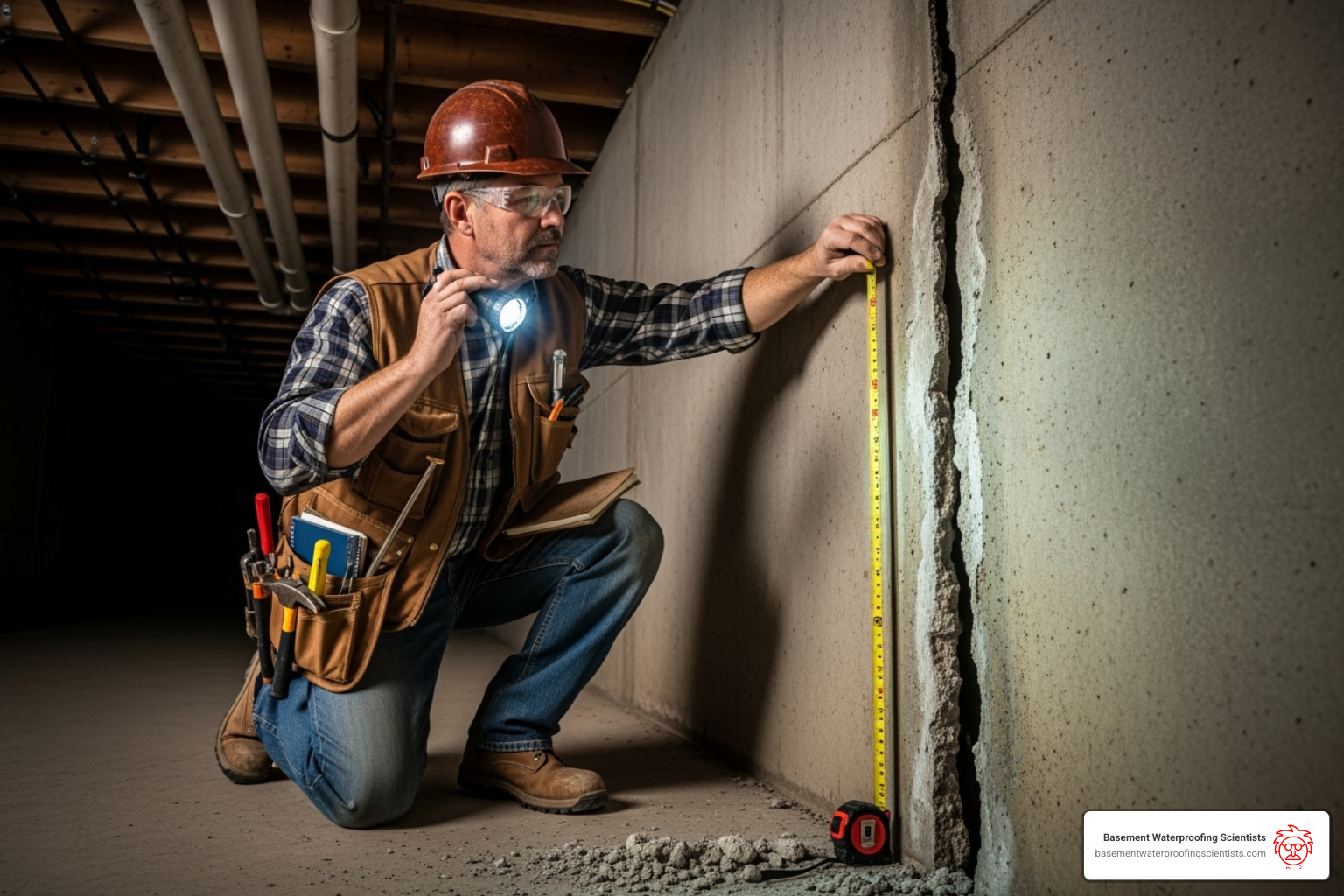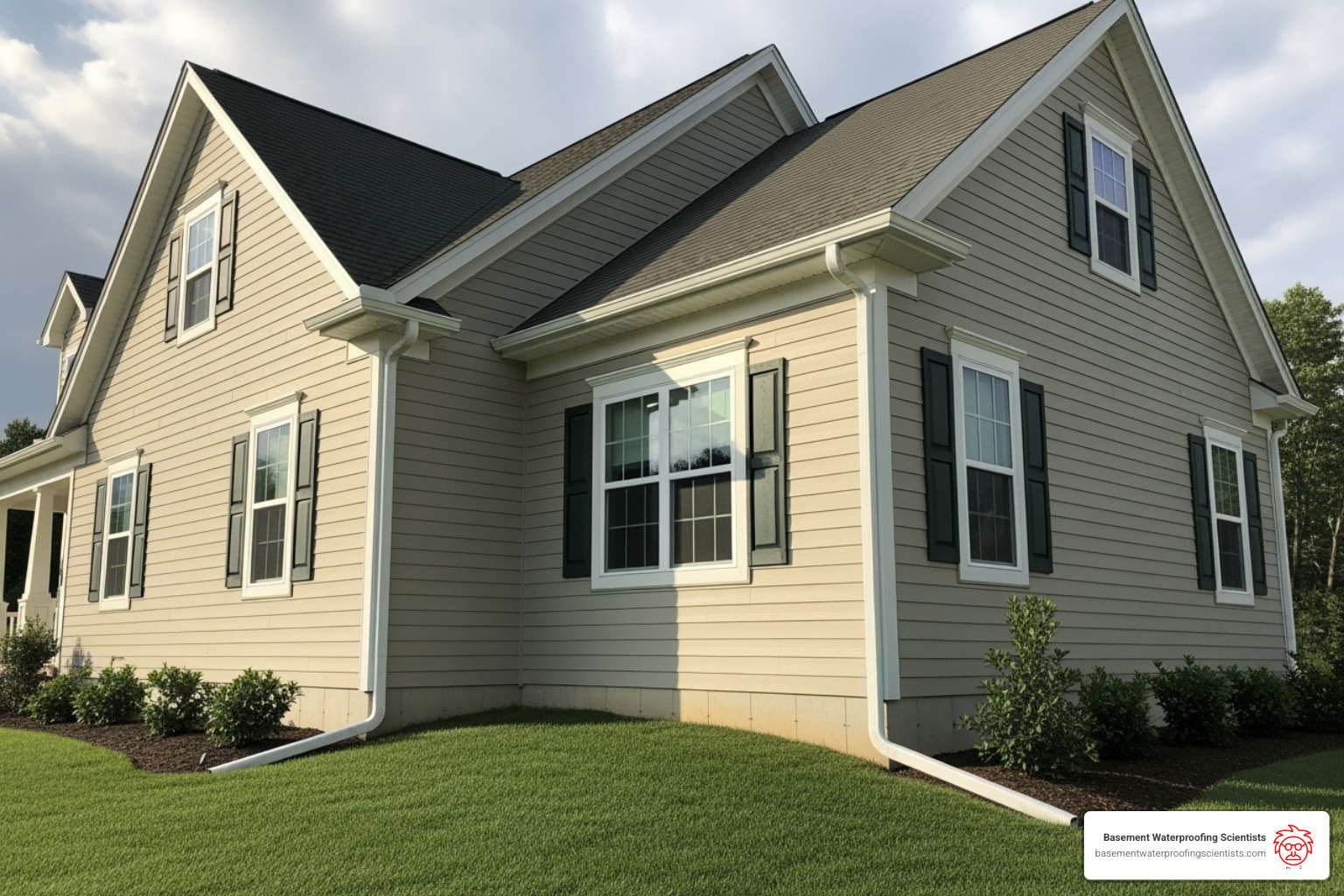Why Sealing Small Foundation Cracks Matters for Your Home
Sealing small cracks in foundation walls is a critical preventive maintenance task. Even hairline cracks can allow water, pests, and radon gas into your home, while larger cracks may signal serious structural problems.
Quick Answer for Sealing Small Foundation Cracks:
- Hairline cracks (width of sewing thread): Apply masonry paint for a cosmetic fix.
- Cracks 1/8″ to 1/4″ wide: Use concrete-compatible caulk or sealant.
- Cracks wider than 1/4″: Call a professional immediately.
- Horizontal or stair-step cracks: Always require professional assessment.
- Any crack with water seepage: Needs a professional waterproofing solution.
Ignoring a small crack can be a costly mistake. As one homeowner noted, a small crack they weren’t worried about eventually led to moisture in their crawl space after a bad winter. Foundation problems only get worse, and what starts as a minor issue can escalate into a major water intrusion problem, with basement waterproofing costs averaging between $4K and $8K.
Some hairline cracks from normal concrete shrinkage are harmless, but others indicate soil settlement or hydrostatic pressure that threatens your home’s structural integrity.
I’m Darin Garvey, and with over 30 years of experience in basement waterproofing, I’ve seen how sealing small cracks in foundation walls early can save homeowners thousands. My team at Basement Waterproofing Scientists specializes in identifying which cracks need immediate attention and which can be safely monitored.

Common sealing small cracks in foundation vocab:
Understanding Foundation Cracks: Causes and Severity
Most foundation cracks are not a disaster, but it’s crucial to know the difference between normal settling and a serious issue. The primary causes of foundation cracks include:
- Concrete Shrinkage: As new concrete cures and dries, it naturally shrinks, often creating thin, vertical hairline cracks. This is a common and usually harmless process.
- Soil Settlement: The ground beneath your home naturally compacts and shifts over time, which can cause manageable vertical or diagonal cracks.
- Hydrostatic Pressure: This is a more serious issue where water-saturated soil exerts immense force on foundation walls. This pressure is a primary cause of dangerous horizontal cracks.
- Temperature Changes: The expansion and contraction of concrete during seasonal temperature swings in Pennsylvania, New Jersey, and Delaware can create stress fractures over time.
Understanding the type of crack is key to assessing its severity:
- Vertical and Diagonal Cracks: These are often the least concerning, typically caused by shrinkage or minor settlement. If they are narrower than 1/8 inch, they can usually be monitored or sealed.
- Horizontal Cracks: Running sideways, these cracks almost always indicate severe hydrostatic pressure. If you see a horizontal crack, especially if the wall is bowing, call a professional immediately.
- Stair-Step Cracks: Found in block or brick foundations, these zigzag cracks suggest uneven (differential) settlement, which requires expert assessment.
Key warning signs that demand immediate attention include cracks wider than 1/8 inch, any bulging or bowing walls, and water seepage through a crack of any size.
For more detailed information about issues you might see from the outside, check out our guide on exterior foundation cracks.
Are All Foundation Cracks a Serious Problem?
No, many cracks are normal and don’t threaten your home’s structure. Hairline shrinkage cracks are an inevitable part of concrete curing, and small vertical or diagonal cracks from normal settling (less than 1/8 inch wide) are also common. However, even these non-structural cracks can allow water, pests, or radon gas to enter your home, which is why sealing small cracks in foundation walls is smart preventive maintenance.
Monitoring cracks is crucial. A simple way to do this is the pencil test: draw lines at each end of the crack, write the date, and take dated photos with a ruler for scale. Check monthly to see if the crack has grown in length or width.
Certain signs of structural issues require immediate professional attention:
- Cracks wider than 1/8 inch that continue to grow.
- Horizontal or stair-step cracks.
- Other clues around the house, such as sloping floors, sticking doors and windows, or new drywall cracks.
If you notice these warning signs, don’t guess the cause. Schedule a professional inspection with our team for an accurate diagnosis.
The Risks of Ignoring Even Small Cracks
Ignoring even a small foundation crack can lead to significant problems and expenses. Here are the primary risks:
- Water Intrusion: Even hairline cracks can allow water in, leading to basement flooding and water damage.
- Mold and Mildew: Moisture from leaks creates a breeding ground for mold, which can cause health problems and damage stored belongings.
- Pest Entry: Cracks provide an easy entry point for insects, rodents, and other pests.
- Radon Gas: This dangerous, cancer-causing gas can seep into your home through foundation cracks.
- Compromised Structural Integrity: Water entering cracks can freeze and expand, widening the crack and weakening the foundation over time.
- Decreased Property Value: Unrepaired cracks and water issues can significantly lower your home’s value and deter potential buyers. Basement waterproofing costs typically range from $4K to $8K, a cost buyers will factor into any offer.
Addressing cracks early is a smart investment that protects your property and your family’s health. To better understand potential costs, see our guide on the cost to fix a basement leak.
A Step-by-Step Guide to Sealing Small Cracks in Foundation
For stable, non-structural cracks less than 1/4 inch wide, a DIY repair may be an option. However, if you have any doubt about the crack’s nature, a professional inspection is the safest choice.

1. Safety First: Always wear work gloves, safety glasses, and a dust mask or respirator. The chemicals and concrete dust can be hazardous.
2. Surface Preparation: A successful repair depends on a clean surface. Start by cleaning the crack thoroughly with a wire brush to remove all loose concrete, dirt, and old filler. Then, use a shop vacuum to remove all dust and debris.
3. Ensure the Crack is Dry: Most sealants require a completely dry surface to bond correctly. If the crack is damp, use a blow-dryer or wait for it to dry. Persistent dampness indicates an active water problem that requires professional attention before sealing.
Methods for Sealing Small Cracks in Foundation
With the crack prepped, choose your repair method. For DIY sealing small cracks in foundation walls, the main options are caulk or an injection kit.
Using Concrete-Compatible Caulk (for cracks up to 1/4 inch):
- Choose a flexible, polyurethane-based caulk for durability.
- Apply a continuous bead of sealant along the crack, forcing it deep into the opening.
- Smooth the bead with a putty knife or gloved finger, feathering the edges.
- Allow the sealant to cure for at least 24 hours.
Using a DIY Injection Kit (for a deeper seal):
- Choose an epoxy kit for structural strength or a polyurethane foam kit for waterproofing.
- Install the included injection ports along the crack according to the kit’s instructions.
- Apply the surface sealer over the crack and around the ports, then let it cure.
- Inject the epoxy or foam into the ports, starting from the bottom and working your way up.
While DIY kits can be effective for minor cracks, they provide a less durable seal than professional injection methods. For detailed product recommendations, check out our guide on concrete wall crack sealers.
Choosing the Right Sealant for Your Foundation Crack
The right sealant depends on the crack’s nature and your goal. Here’s a comparison of common materials:
- Concrete-Compatible Caulk: Best for small (up to 1/4 inch), non-moving cracks. It’s a flexible, easy-to-apply surface fix but offers no structural support.
- Hydraulic Cement: Can stop active leaks in wider, stable cracks. However, it’s rigid and will re-crack if the foundation shifts.
- Polyurethane Foam Injection: The professional choice for waterproofing (90-95% of repairs). It expands to fill the entire crack and remains flexible to handle minor movement. It does not add structural strength.
- Epoxy Injection: Used for structural repairs (5-10% of repairs). It bonds the concrete together, restoring its strength. However, it is rigid once cured and not suitable for foundations that are still moving.
The main difference is structural repair (epoxy) vs. waterproofing (polyurethane). For the freeze-thaw cycles common in our region, polyurethane’s flexibility is often a major advantage.
It’s also important to note that professional injection systems use high pressure (3000-5000 PSI) to ensure the sealant fills the entire crack, from front to back. DIY kits use low-pressure caulk guns, which is a primary reason why DIY repairs often fail over time.
When to Call a Professional for Foundation Repair
Recognizing the limits of DIY repair is key to protecting your home. Attempting to fix a serious issue yourself can lead to a costly disaster. It’s time to call an expert when you see these warning signs:

- Horizontal or Stair-Step Cracks: These indicate serious pressure or uneven settling that a surface seal can’t fix.
- Cracks Wider Than 1/4 Inch: Large cracks signal significant stress or movement that requires professional intervention.
- Growing Cracks: If monitoring shows a crack is getting longer or wider, the foundation is actively moving and needs a structural solution.
- Bulging or Bowing Walls: A wall that is pushed inward or outward is a sign of structural failure and requires immediate assessment to prevent collapse.
- Multiple or Extensive Cracks: Widespread cracking suggests a systemic problem with soil, drainage, or the structure itself.
- Other Structural Symptoms: Sticking doors, sloping floors, and new drywall cracks throughout the house point to a foundation issue affecting the entire home.
- Persistent Water Leaks: If a crack continues to leak after a DIY repair attempt, a professional is needed to find and fix the true source of the water.
Foundation problems don’t fix themselves. When in doubt, it’s always safer and more cost-effective to consult an expert. Learn more about professional foundation repair and why it’s crucial for serious issues.
The Advantages of Professional Crack Repair
Hiring a professional like Basement Waterproofing Scientists is an investment in a permanent solution. You benefit from:
- Expert Diagnosis: With 30 years of experience, we accurately identify the root cause of the crack—be it hydrostatic pressure, soil settlement, or drainage issues—to ensure the right repair is performed.
- Specialized Equipment: We use high-pressure injection pumps (3,000-5,000 PSI) that force sealant deep into the crack, creating a complete, durable bond that low-pressure DIY kits can’t match.
- High-Quality Materials: We use industrial-grade polyurethane for flexible, waterproof seals and professional epoxy for repairs that require restoring structural strength.
- Structural Reinforcement: For serious issues, we offer advanced solutions like carbon fiber strapping to strengthen the foundation against future pressure.
- Lifetime Guarantee: Our repairs come with a transferable lifetime warranty, providing peace of mind and adding value to your home.
- Long-Term Solutions: We focus on fixing the underlying problem, not just the crack, to prevent future issues.
Repair Costs: Professional vs. Attempting It Yourself
While DIY seems cheaper upfront, it’s important to consider the long-term costs.
- DIY Material Costs: A tube of caulk is under $20, and injection kits range from $75 to $225.
- Professional Repair Costs: Interior injection for a single crack typically costs $500 to $2,500. More extensive repairs, like exterior excavation, can start at $5,000 or more. A full waterproofing system averages $4K to $8K.
The true cost of a failed DIY repair includes not only the initial materials but also the expense of fixing subsequent water damage, mold growth, and a potentially worsened crack. The cost of inaction is even higher, with major water damage restoration costing tens of thousands and decreasing your home’s value by 10% or more.
A professional repair is an investment in a permanent, warrantied solution that protects your home’s value and prevents far greater expenses down the road.
For some insight into the materials that make up your foundation, you can read more about what is portland cement?.
How to Prevent Foundation Cracks
Prevention is far better than repair. While you can’t stop all cracks (concrete shrinkage and minor settling are normal), you can prevent serious problems by managing water around your home. Excess water creates hydrostatic pressure, the main cause of severe foundation damage.

Here are key water management strategies:
- Maintain Gutters and Downspouts: Clean your gutters seasonally to prevent overflows. Ensure downspouts extend at least 5 to 10 feet away from the foundation to direct water safely away.
- Ensure Proper Soil Grading: The ground around your house should slope away from the foundation (a drop of 6 inches over 10 feet is ideal). Add topsoil to low spots where water might pool.
- Landscape Wisely: Avoid planting large trees or shrubs close to the foundation, as their roots can cause damage. Ensure landscape beds have proper drainage and don’t trap water against the house.
- Conduct Regular Inspections: A few times a year, walk around your property and through your basement to check for new cracks or signs of moisture, especially after heavy rain.
Long-Term Strategies for a Healthy Foundation
For more robust, long-term protection, consider these systematic approaches to controlling soil moisture:
- Sump Pump Installation: A sump pump is a critical defense, collecting groundwater in a basin and pumping it away before it can build up pressure against your foundation walls.
- Interior Drainage Systems: An interior French drain collects water that seeps in at the wall-floor joint and channels it to the sump pump, keeping your basement floor dry. This is a highly effective and less disruptive solution.
- Exterior Drainage Systems: For severe water problems, an exterior system uses perforated pipes around the foundation’s perimeter to capture groundwater before it reaches the wall. Though it requires excavation, it is extremely effective.
These systems work together to create layers of protection. Explore these strategies in our comprehensive guide to waterproofing your foundation.
Preventing Future Problems After Sealing Small Cracks in Foundation
After sealing small cracks in foundation walls, the work isn’t over. To ensure the repair lasts and to prevent new issues, follow these steps:
- Monitor Your Repairs: Periodically check the sealed crack for any new signs of failure, such as moisture or new hairline fractures nearby.
- Check for New Cracks: Regularly inspect your entire foundation, as stress can sometimes shift and cause new cracks to appear elsewhere.
- Address Underlying Water Issues: A crack repair is only a permanent fix if the root cause is addressed. If water pressure caused the crack, you must improve your drainage (gutters, grading) to prevent it from happening again.
- Maintain Drainage Systems: Continue to clean your gutters, check your downspouts, and test your sump pump annually to ensure your water management system is working effectively.
Proactive maintenance is the key to protecting your foundation and your home’s value.
Frequently Asked Questions about Sealing Foundation Cracks
Here are answers to some of the most common questions we hear about sealing small cracks in foundation walls.
Can I just paint over a small foundation crack?
For a tiny, non-leaking hairline crack, waterproof masonry paint can be a temporary cosmetic fix. However, paint only covers the surface; it doesn’t seal the crack through the wall or address the underlying cause. Water will eventually seep through. For any crack showing moisture, proper sealing is necessary.
How long does a foundation crack repair last?
The longevity of a repair depends on three things: the quality of the material, the quality of the application, and the stability of the foundation. A basic DIY caulk repair might last a few years. A professional injection repair that also addresses the root cause of the crack should be a permanent solution, which is why we offer a lifetime guarantee.
Is it better to seal a crack from the inside or the outside?
Technically, sealing from the exterior is the best method because it stops water before it enters the wall. However, this requires costly and disruptive excavation. Modern interior injection sealing is a highly effective and more practical alternative. Using high-pressure pumps, we can fill the crack through its entire thickness from the inside, creating a durable, watertight seal that is less invasive and more cost-effective for most homeowners.
Protect Your Home’s Foundation for Good
With the right knowledge and timely action, you can protect your home from the risks of foundation cracks. The key takeaway is that sealing small cracks in foundation walls early can prevent a cascade of problems, from water damage and mold to serious structural issues.
While some minor cracks are suitable for a DIY approach, it’s crucial to know your limits. Horizontal cracks, growing cracks wider than 1/4 inch, or any crack with active water leaks are signs that you need professional help immediately.
At Basement Waterproofing Scientists, we use our 30 years of experience and specialized equipment to identify the true source of foundation problems, allowing us to provide lasting solutions for less. Our commitment is to get the job right the first time, which is why our work is backed by a transferable lifetime guarantee.
Don’t let a small crack become a big headache. Our team provides customized solutions to keep your basement dry for good. We serve homeowners throughout Philadelphia, Reading, Norristown, Pottstown, Bensalem Township, Upper Darby Township, Bristol Township, Middletown Township, Lansdale, Warminster Township, Springfield Township, Haverford Township, Radnor Township, Willow Grove, King of Prussia, Horsham, Exeter Township, Cumru Township, Ardmore, Bryn Mawr, Quakertown, Royersford, Conshohocken, Hatboro, Collegeville, and throughout Pennsylvania, New Jersey, and Delaware.
Your home’s foundation is its backbone. Protect it with the expertise it deserves. Schedule your expert inspection for basement wall crack repair today and gain peace of mind knowing your foundation is in the best hands.

